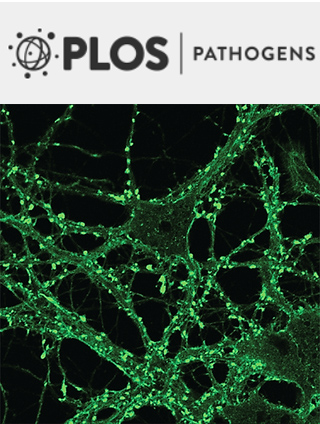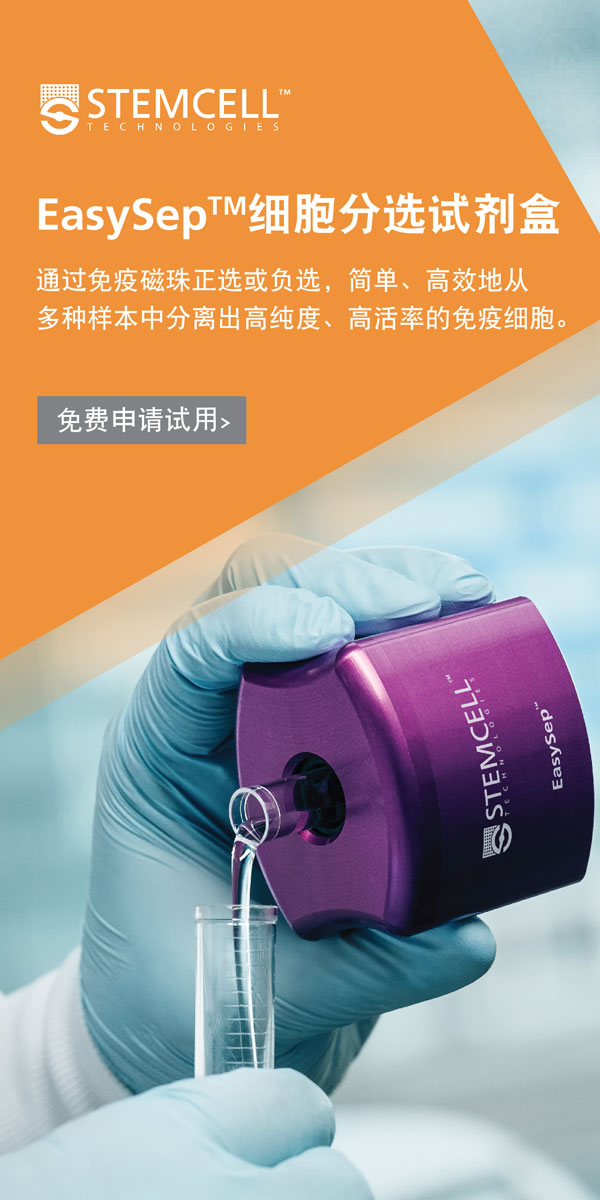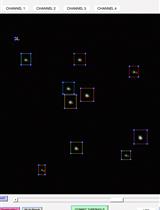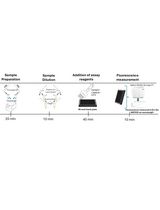- EN - English
- CN - 中文
Hypochlorous Acid Staining with R19-S in the Drosophila Intestine upon Ingestion of Opportunistic Bacteria
果蝇肠道摄入外来细菌后次氯酸R19-S染色
发布: 2019年05月20日第9卷第10期 DOI: 10.21769/BioProtoc.3246 浏览次数: 6379
评审: Anne-Marie Caroline OverstreetKhyati Hitesh ShahRajesh D Gunage

相关实验方案
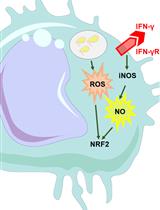
使用荧光酶标仪连续测量受细菌感染的骨髓源性巨噬细胞中活性氧的生成
Natascha Brigo [...] Christa Pfeifhofer-Obermair
2023年02月05日 2396 阅读
Abstract
The intestine is endowed with an innate immune system that is required to fight any exogenous bacteria that are swallowed along with the food. The first line of defense that is mounted by the gut epithelium is the release of immune Reactive Oxygen Species (ROS), such as hypochlorous acid (HOCl), into the lumen. HOCl is produced within 1.5 h of bacterial ingestion and is very labile once released. Therefore, to monitor HOCl production upon ingestion of allochthonous bacteria, one needs a detection system that can quickly and efficiently detect HOCl production in the intestine. While most of the ROS-sensitive probes available in the market detect all kinds of ROS without any distinction, the R19-S fluorescent probe has been developed to specifically detect HOCl. Here, we describe a protocol to monitor HOCl production using this probe in the gut lumen of adult Drosophila upon ingestion of the opportunistic bacteria Bacillus thuringiensis.
Keywords: Intestine (肠道)Background
The evolutionarily conserved innate immune system is the first line of defense against pathogenic bacteria. In the gut, the local innate immune system first produces Reactive Oxygen Species (ROS) to damage bacterial wall and slow down the proliferation of ingested bacteria (Kim and Lee, 2014). Then, the visceral mesoderm triggers spasmodic contractions to favor bacterial eviction (Benguettat et al., 2018). The third line of defense is the production of antimicrobial peptides that kill the bacteria (Xia et al., 2017). Finally, the gut is able to regenerate damaged epithelial cells to maintain gut integrity, avoiding bacterial entry into the internal milieu (Bonfini et al., 2016). In Drosophila, the immune ROS are produced by the enterocytes of the anterior midgut in a DUOX-dependent manner between 0.5 and 1.5 h after bacterial ingestion. The main immune ROS to be released in the gut lumen is hypochlorous acid (HOCl) (Lee et al., 2013; Benguettat et al., 2018). Therefore, HOCl monitoring is a good proxy for the gut innate immune response to a microbe. However, HOCl is a very labile compound that quickly disappears once it is released into the lumen. Here, we describe a protocol that we designed to efficiently detect HOCl production in the gut lumen of adult Drosophila upon ingestion of low doses of the Gram-positive Bacillus thuringiensis kurstaki (Btk) opportunistic bacteria. This protocol can equally be used to detect HOCl upon ingestion of any other pathogens and it also can be used to measure HOCl production in the gut of Drosophila larvae.
Materials and Reagents
- Drosophila rearing
- 6 oz Drosophila stock bottles (Genesee Scientific, catalog number: 32-130)
- Cotton balls for stock bottles (Genesee Scientific, catalog number: 51-102B)
- CantonS flies (Bloomington Drosophila Stock Center, catalog number: 64349) (flystocks.bio.indiana.edu)
- Agar (VWR, BDH®, catalog number: 20768-361)
- Sugar (Carrefour or any other supermarket)
- Cornflour (AB, Celnat-NaturDis)
- Yeast (Biospringer, catalog number: BA10/0-PW)
- Tegosept (Apex, Fly Food preservative, Genesee Scientific, catalog number: 20-258)
- Standard nutrient medium for Drosophila (see Recipes)
- Bacterial culture
- Petri dishes (Thermo Scientific-NuncTM, catalog number: 263991)
- Sterile tips (Sigma Aldrich, catalog number: CLS4138)
- 15 ml tubes (Corning, Falcon®, catalog number: 352096)
- Graduated cylinder (Azlon, catalog number: 11940985)
- Bacillus thuringiensis var. kurstaki (Btk) strain identified under the code 4D22 at the Bacillus Genetic Stock Center (http://www.bgsc.org/) and described by Gonzalez et al., 1982
- Luria broth powder (Conda, catalog number: 1551)
- Agar bacteriological (Euromedex, catalog number: 1330)
- LB medium (see Recipes)
- LB-agar medium (see Recipes)
- Inoculation
- Cotton balls for 25 mm narrow vials (Genesee Scientific, catalog number: 51-101)
- Spectrophotometry cuvettes (Ratiolab, catalog number: 2712120)
- 2 ml microtubes (Paul Boettger, catalog number: 02-043)
- 20 mm filter disks (3 MM Chr chromatography paper; GE Healthcare, catalog number: 3030-917)
- 50 ml tubes (Fisher Scientific, catalog number: 10788561
- 25 mm narrow Drosophila vials (Genesee Scientific, catalog number: 32-109RL)
- Sucrose (Euromedex, catalog number: 200-301-B)
- 5% sucrose (see Recipes)
- 1 mM R19-S (Futurechem, FC-8001, Seoul, South Korea) (see Recipes)
- Dissection
- 10x PBS (Euromedex, catalog number: ET330)
- 1x phosphate-buffered saline (PBS) (see Recipes)
- Assay
- 1.5 ml microtubes (Paul Bottger, catalog number: 02-063)
- 12-well black microplates (VWR international, catalog number: 734-2324)
- Aluminum foil (available at any supermarket)
- Formaldehyde 16% (Thermo Scientific, catalog number: 28908)
- Vectashield/DAPI (Sigma, catalog number: F6057)
- 4% Formaldehyde (see Recipes)
Equipment
- Drosophila rearing
Refrigerated oven at a constant temperature of 25 °C and with a 12 h/12 h light/dark cycle (Fisher Scientific, catalog number: 11857552). Humidity must be maintained between 40% and 70%. - Bacterial culture
- 500 ml sterile flask
- 30 °C shaking incubator (Infors, model: AK 82)
- Inoculation
- Spectrophotometer (Aqualabo, Secomam, model: Prim Light & Advanced)
- CO2-anesthesia system (INJECT+MATIC sleeper)
- Dissection
- Dumont forceps #5 (Fine Science Tools, catalog numbers: 11251-20 and 11252-20)
- Watch glass (Steriplan Petri dishes, DWK Life Sciences, catalog number: 237554008)
- Stereomicroscope (Leica Microsystems, model: Leica M60)
- Assay
Florescent microscope (Zeiss Axio Imager Z1 Apotome) equipped with a camera (AxioCam MRm) and a Rhodamine 43 fluorescent filter
Software
- ZEN 2012 (Zeiss)
- ImageJ (https://imagej.nih.gov/ij/)
- Kyplot (http://kyenslab.com/en/index.html)
- Excel (Microsoft)
Procedure
文章信息
版权信息
© 2019 The Authors; exclusive licensee Bio-protocol LLC.
如何引用
Hachfi, S., Benguettat, O. and Gallet, A. (2019). Hypochlorous Acid Staining with R19-S in the Drosophila Intestine upon Ingestion of Opportunistic Bacteria. Bio-protocol 9(10): e3246. DOI: 10.21769/BioProtoc.3246.
分类
免疫学 > 动物模型 > 果蝇
细胞生物学 > 细胞成像 > 荧光
生物化学 > 其它化合物 > 活性氧
您对这篇实验方法有问题吗?
在此处发布您的问题,我们将邀请本文作者来回答。同时,我们会将您的问题发布到Bio-protocol Exchange,以便寻求社区成员的帮助。
Share
Bluesky
X
Copy link


